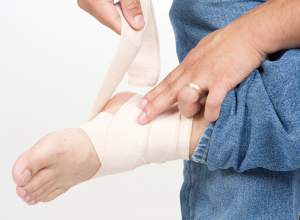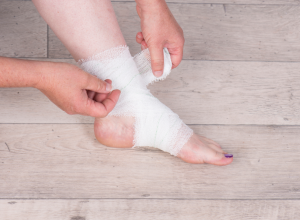
RICE Protocol
The RICE protocol is a mnemonic comprised of four elements used to treat soft tissue injuries and sprains caused by sports and other activities. RICE is an acronym for rest, ice, compression and elevation, all of which are considered types of first aid treatment that can promote healing and relieve pain and swelling.
The Four Elements of RICE
Rest
This is probably the most important aspect of the RICE protocol, as the body cannot begin to heal if the affected area is forced to continue working. Additionally, if rest is not taken, the chances of chronic inflammation and abnormal repair increase.
Ice
The coldness of ice quickly helps reduce inflammation and eases pain. It’s best to wrap the ice in a towel or other protective material and then apply the ice for a short period of time (15 to 20 minutes) once an hour. Some experts believe that over-icing can delay healing, so it’s best to stick to the above alternation method.
Compression
Some swelling is inevitable, but compression can help control the level of edema and prevent significant loss of function and excessive pain. Usually compression is achieved via an elastic bandage or compression stockings and sleeves (an ACE bandage, for example). Compression bandages should be snug but not too tight that they significantly restrict blood flow.
Elevation
Elevating the injured area above the level of your heart is said to help increase the venous return of blood to circulation, which can help with edema and pain.
Nonsteroidal anti-inflammatory drugs (NSAIDs) are often used in conjunction with the RICE method. Their addition can turn RICE into PRINCE, which is protection, rest, ice, NSAIDs, compression, elevation or into HI-RICE, which is hydration, Ibuprofen, rest, ice, compression, elevation.
Controversy
While many experts agree that the RICE method is the best first aid treatment for tissue injuries, some disagree and say the MEAT method (movement, exercise, analgesics and treatments) is best, as it increases rather than decreases blood flow to the inured area. Gabe Mirkin, the author who first introduced the RICE method in 1978, says, “Coaches have used my ‘RICE’ guideline for decades, but now it appears that both Ice and complete Rest may delay healing, instead of helping...In a recent study, athletes were told to exercise so intensely that they developed severe muscle damage that caused extensive muscle soreness. Although cooling delayed swelling, it did not hasten recovery from this muscle damage.”
Notice concerning medical entries:
Articles having medical content shall serve exclusively for the purpose of general information. Such articles are not suitable for any (self-) diagnosis and treatment of individual illnesses and medical indications. In particular, they cannot substitute for the examination, advice, or treatment by a licensed physician or pharmacist. No replies to any individual questions shall be effected through the articles.








